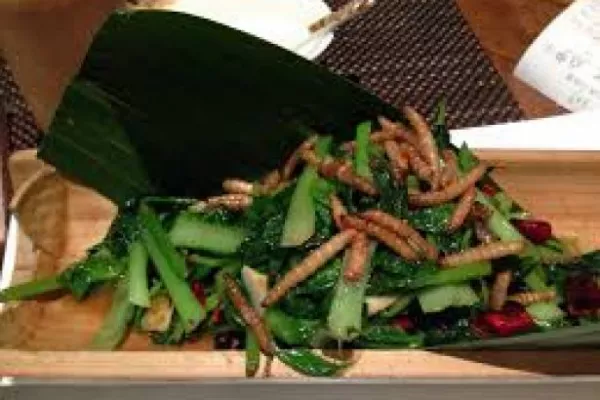Thailand’s long been known for its street carts of deep-fried, heavily salted insects, often surrounded by tourists keen to crunch on a grasshopper for an Instagram hit. But bugs are going up in the world and being given a distinctly European makeover.
Insects in the Backyard is thought to be the country's first restaurant to look past the deep fryer and utilize the six-legged critters as fine-dining ingredients. Executive Chef Mai Thitiwat stuffs fresh ravioli with crab and water beetle meat, creates a beurre blanc sauce infused with ant eggs for its acid kick, and mixes powdered silk worm with mascarpone cheese for his creamy tiramisu. “I’m not making scary food,” he says.
For those entomophagists—insect eaters—craving something more obviously leggy, there are whole bugs to be found lurking in some dishes. But a number of menu items are insect-free altogether. “No one should feel pressured to consume something they don’t feel comfortable with,” explains Regan Suzuki Pairojmahakij, concept consultant and co-owner of the restaurant, located in Bangkok's new Chang Chui creative hub. “We do note, however, that a Western customer base prefers the insects not to be visible in insect form, whereas Asian customers are much more comfortable with seeing insect parts.” So, how would you eat yours?
For starters: Watermelon salad with herbed creme fraiche, chorizo, and bamboo caterpillars. The crunchy fried caterpillars that adorn this dish taste rather like squid, according to Mai Thitiwat, executive chef at Insects in the Backyard. They're among the most expensive creepy-crawlies on the menu, sourced from a farm in northern Thailand at a cost of 120 baht ($3.60) a kilo.
High in protein, minerals, and healthy fats and hugely abundant, some 1,900 species of insect supplement the diets of 2 billion people worldwide, according to the UN Food and Agriculture Organization.
Fresh pasta made with cricket flour, topped with fried crickets, black basil pesto, and chorizo. Grinding the insect into a flour gives a nutritional kick absent from regular pasta, while the crickets can be deep-fried or sautéed whole to offer a nutty flavor—and a crunch.
Ingredients used in some of the dishes (clockwise from top left): ant, grasshopper, ant eggs, white cricket, giant water beetle, bamboo caterpillar, and silkworm.
Most of the insects used in the restaurant are sourced from family-run farms around Thailand and raised in chemical-free environments, says co-owner Regan Suzuki Pairojmahakij.
Insects in the Backyard draws on American, French, Italian, and Mediterranean influences, while incorporating Thai and regional flavors.
Crab and giant water beetle ravioli with turmeric saffron sauce. Water beetle tastes a little like crab and has a similar texture, according to Mai. To prepare the dish he roasts the insects before removing their shells and pulling out the meat. Each beetle provides three to four grams of meat, and it takes about 20 of them to make one ravioli dish.
Ants and their eggs are both used in Mai's dishes. While the insects are crispy, the larvae are soft and acidic.
Grilled sea bass with "ant caviar" beurre blanc sauce, pan-fried queen ants, and corn salsa. The ant eggs in the beurre blanc sauce impart an acidity which, in fish dishes, more often comes from lemons. The delicate larvae cannot be cooked on a high heat and are gently introduced as the sauce is tempered. The ants themselves are pan-fried to a crisp and served on the fish.
A grasshopper's leg pokes out of a bowl shortly before the creature is transformed into a fine-dining delicacy.
Mai prepares lobster and grasshopper bisque risotto with seafood and sundried tomatoes. Grasshoppers stem from the same family as shrimp and have a similar flavor. The chef plates the crunchy invertebrates whole for aesthetic reasons, but he recommends removing the legs before eating.
The elegant lobster and grasshopper bisque risotto.
A bowl of fat silkworm pupae, ready to roast. The restaurant has sourced the silkworms from a farm that feeds them corn, giving them a yellow color and imparting the flavour of the grain, says Mai.
And for dessert, an Italian tiramisu made with silkworm powder and topped with three of the pupae.
News by Bloomberg - edited by Hospitality Ireland









